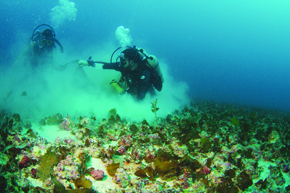
RICARDO LEÃO DE MOURA / UFRJResearchers conduct fieldwork on the rhodoliths of the Abrolhos Bank RICARDO LEÃO DE MOURA / UFRJ
The world’s largest concentration of coralline algae that form rhodoliths feeds the South Atlantic with an enormous variety of marine life, nutrients and energy, according to a recent study published in the August 29, 2013 issue of ISME Journal. Located along the Abrolhos Bank, located between the southern part of Bahia State and the northern part of Espírito Santo State in Brazil, the layers of limestone nodules formed over thousands of years by these algae cover nearly 21,000 km2 of the continental shelf. The study coordinated by Fabiano Thompson and Rodrigo Moura of the Federal University of Rio de Janeiro, and Gilberto Amado Filho from the Botanical Garden of Rio de Janeiro, involved the help of 11 more researchers from Brazil and Japan, in an effort to understand the ecological role of the rhodoliths and the organisms that inhabit these structures. “Rhodliths act like a condominium for marine life, offering habitat to larvae and young cnidarians, nematodes, mollusks and arthropods,” explains Thompson. “They serve as a continuous source of fertilizer for the ocean.” The study also suggests that various microorganisms associated with the rhodoliths help the algae produce limestone from the carbon and calcium dissolved in the seawater. By measuring the photosynthetic activity of the algae, the researchers estimated that this rhodolith bed is producing 565,000 tons of organic carbon every day (equivalent to the mass of 3,000 humpback whales). This corresponds to $500 billion in carbon credits a day. The ecosystem is at risk of shrinking, however, due to mineral extraction and the acidification of the oceans.
Republish